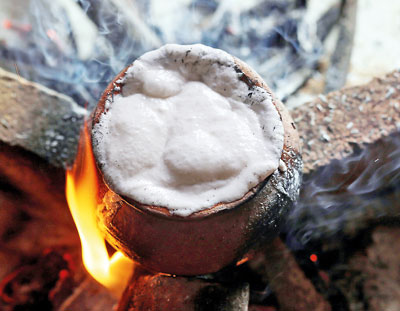Dawn of Bak and its religious and cultural significance

An auspicious time for everything: Boiling a pot of milk over a hearth. Pic by M.A. Pushpa Kumara
Bak Full Moon Poya falls on April 10 and the Sinhala and Tamil New Year on the 14th. Good Friday is also on April 14. Therefore the coming week is very significant for Sri Lankans.
It was on a Bak Full Moon Poya that the Buddha visited Sri Lanka. Buddha with his divine eye surveyed the world and observed a dispute brewing between two Naga communities in Lanka (Sri Lanka). The two Naga kings Mahodara and Chulodara were uncle and nephew. The dispute between uncle and nephew was over a gem-studded throne.
Five years after the attainment of Supreme Enlightenment, the Buddha visited the Nagadipa in the north of Lanka (Sri Lanka), accompanied by the tree deity Samiddhi Sumana. Appearing over the battlefield, he first created a darkness, a gloom. The Nagas were frightened. Next, he created a brilliant light which illuminated the whole battlefield. This miracle was witnessed by the Nagas. The Buddha addressed the Nagas taking examples from the Jataka stories of animals and birds and the futility of controversy in the settling of disputes. Buddha said “victory brings hatred and the vanquished live in misery.”
Listening to the Buddha’s Doctrine, the Naga kings gave up their desire to fight. The gem studded throne was offered to the Buddha. After his discourse, he returned it to the two kings who made a Chaitya and placed this valuable throne in it to pay homage to the Buddha.
Bak is the first month of the Sinhala Almanac. The month of Bak (April) is very important to both Sinhala and Tamil farmers. After their harvest of paddy and other crops, they perform a thanksgiving ceremony and observe many customs and rituals.
Aluth Avuruddha (New Year) and in Tamil Puththandu is celebrated when the Sun moves from Meena Rashiya to the Mesha Rashiya. Derived from the Sanskrit word Bhagya, Bak is associated with fortune and prosperity.
In the days before the New Year, people clean their homes in preparation for the Aluth Avuruddha. In the villages, the hearth is repaired, using cowdung and the floor spread with it if not cemented! Traditional sweetmeats such as kondakavun, kokis, athirasa, aggala, asmi, aluva etc. are prepared.
On the 13th, the last day of the Parana Avuruddha (old year) certain customs and rituals are performed. Between the old and new year, there is a time of ‘nonagetha’ during which people do not do their normal work but attend temples to perform religious activities. Neighbours are visited with sweetmeats. In the village the Aluth Avuruddha is centred round the village temple. At auspicious (nekath) times the Hevisi (drumming) and the pealing of the temple bell is heard. In villages mostly farming communities, Aluth Avurudu celebrations are most important. Farmers are thankful for a good harvest, and follow all the customs and rituals with great devotion to a Buddhist way of life.
Offering of a sheaf of betel leaves to elders and parents is an important custom. The elders touch the head of the young ones and bless them. According to the Nekath times, the hearth is lit with all the family members seated around it, a pot of milk is boiled until it spills over on the floor. Ganu-denu (exchanging money), gifting clothes are part of the celebrations. The prepared food is eaten facing a certain direction according to the Nekatha.
On Avuruddhu Day, people take part in games such as pora pol gaseema, bellan demeema, kamba adeema and other traditional games. Young ones enjoy the swings shrieking joyfully.
Hindus also follow certain rituals when celebrating ‘Puththandu’ (New year). Mr. Thiagarah, a devout Hindu explained that the auspicious times for the rituals differ slightly from the Sinhala Almanac by just a few seconds or minutes. They too clean their homes and on the 13th visit the kovil where the temple priest gives them ‘Maruthu Neer’ – water boiled with various kinds of herbs, leaves, flowers, milk, saffron etc. Early on the 14th they apply the ‘Maruthu Neer’ on themselves before a bath. New clothes are worn according to the auspicious colour in the Almanac.
A rice preparation is made with jaggery, ghee, raisins and cashew nuts and offered first to the Gods and then to family members. The head of the family gives money, betel leaves and paddy. It is ‘Kai Vishem’ to wish them good luck and prosperity. They perform ‘Er Mangalam’ at the auspicious time and Mr. Thiagaraja explained it is “veda alleema”. Farmers start ploughing, teachers start a new lesson, traders open a new account, a craftsman starts his craft and each one will start something new pertaining to their respective vocation – career or occupation. Thereafter relatives and friends will visit and renew their friendship and goodwill.
After the festivities are over, there is an auspicious time for ‘hisa thel gama’ (anointing – applying oil on the head). Some people visit the temple for this where the monk applies the oil, while others perform this ritual at home. Selected medicinal leaves are placed above the head and under the feet before medicinal oil is applied on the head.
Finally, there is an auspicious day and time to leave for work, which is also observed by people to make their working life a success.


